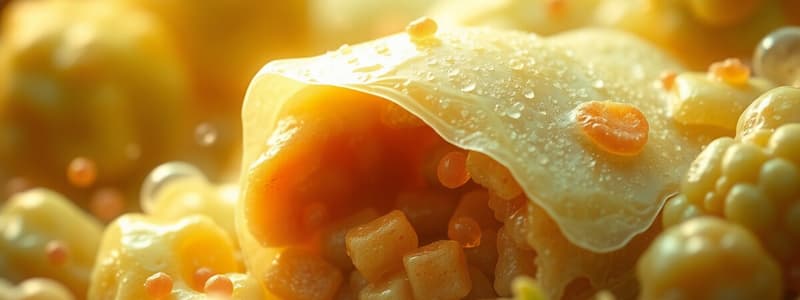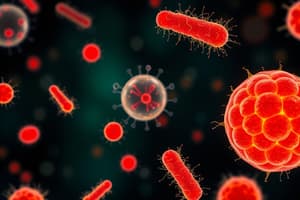Podcast
Questions and Answers
The detection and identification of microorganisms is a critical aspect of food analysis.
The detection and identification of microorganisms is a critical aspect of food analysis.
True (A)
Which genus of bacteria is used in cheese production?
Which genus of bacteria is used in cheese production?
- Streptobacillus (correct)
- Escherichia
- Lactobacillus
- Acetobacter
Which of the following is an example of a single-celled prokaryote?
Which of the following is an example of a single-celled prokaryote?
- Virus
- Mold
- Bacteria (correct)
- Yeast
E. coli at high levels in bean sprouts indicates spoilage.
E. coli at high levels in bean sprouts indicates spoilage.
The abbreviation CFU stands for _______ _______ Unit.
The abbreviation CFU stands for _______ _______ Unit.
What is the term for when bacteria colonize the gut and cause illness?
What is the term for when bacteria colonize the gut and cause illness?
What foodborne illness occurs when bacteria produce a toxin?
What foodborne illness occurs when bacteria produce a toxin?
Intoxification occurs when bacteria only produce a toxin.
Intoxification occurs when bacteria only produce a toxin.
Match the microorganism with its definition:
Match the microorganism with its definition:
Saccharomyces species are used to make which of the following?
Saccharomyces species are used to make which of the following?
Which of the following microorganisms is spread through foods/surfaces?
Which of the following microorganisms is spread through foods/surfaces?
Giardia is classified as a virus.
Giardia is classified as a virus.
What pH range do most microorganisms prefer?
What pH range do most microorganisms prefer?
Acidity has an _________ effect on the growth of most microorganisms.
Acidity has an _________ effect on the growth of most microorganisms.
What is the approximate minimum pH range for bacteria growth?
What is the approximate minimum pH range for bacteria growth?
Which type of microorganism can grow at a pH less than 4.0?
Which type of microorganism can grow at a pH less than 4.0?
Organic acids can minimize spoilage of food because they increase the pH.
Organic acids can minimize spoilage of food because they increase the pH.
What characteristic of fruits, soft drinks, and fermented milk products makes them have excellent keeping qualities?
What characteristic of fruits, soft drinks, and fermented milk products makes them have excellent keeping qualities?
What term describes the availability of water in a food product?
What term describes the availability of water in a food product?
Salinity and water activity are unrelated.
Salinity and water activity are unrelated.
What term describes microorganisms that thrive in high-salt environments?
What term describes microorganisms that thrive in high-salt environments?
Match the temperature range with the correct class of microbe:
Match the temperature range with the correct class of microbe:
Which category of microorganisms thrives best between 20°C and 45°C?
Which category of microorganisms thrives best between 20°C and 45°C?
Most human pathogens are thermophiles.
Most human pathogens are thermophiles.
Which type of organism can grow at 0 °C but prefers 20 °C – 40 °C?
Which type of organism can grow at 0 °C but prefers 20 °C – 40 °C?
____________ need oxygen because they cannot ferment or respire anaerobically.
____________ need oxygen because they cannot ferment or respire anaerobically.
Which type of bacteria is poisoned by oxygen?
Which type of bacteria is poisoned by oxygen?
Which type of microorganism can grow with or without oxygen?
Which type of microorganism can grow with or without oxygen?
Microaerophiles thrive in high concentrations of oxygen.
Microaerophiles thrive in high concentrations of oxygen.
Unlike obligate anaerobes, _______________ are not poisoned by oxygen.
Unlike obligate anaerobes, _______________ are not poisoned by oxygen.
Which of the following is a nutrient required by microorganisms?
Which of the following is a nutrient required by microorganisms?
Acidifying foods is a method of food preservation related to which growth factor?
Acidifying foods is a method of food preservation related to which growth factor?
Salting foods is a method of reducing water activity to prevent microbial growth.
Salting foods is a method of reducing water activity to prevent microbial growth.
Storing food with water activity < 80 helps to prevent _______________ from growing.
Storing food with water activity < 80 helps to prevent _______________ from growing.
Match the method of food preservation to the growth factor that it targets:
Match the method of food preservation to the growth factor that it targets:
What is a common method to rapidly identify a microorganism?
What is a common method to rapidly identify a microorganism?
All microorganisms are harmful in food.
All microorganisms are harmful in food.
Molecular Biology makes use of the ________ of microorganisms.
Molecular Biology makes use of the ________ of microorganisms.
What is the main purpose of culturing or growing organisms?
What is the main purpose of culturing or growing organisms?
Which of the following best describes 'defined media'?
Which of the following best describes 'defined media'?
Most bacteria will grow but can distinguish certain characteristics under selective media.
Most bacteria will grow but can distinguish certain characteristics under selective media.
Flashcards
Microbiological Analysis
Microbiological Analysis
The detection and identification of microorganisms in food.
CFU (Colony Forming Unit)
CFU (Colony Forming Unit)
A unit that estimates the number of viable bacteria or fungal cells in a sample.
Foodborne Infection
Foodborne Infection
Illness caused by bacteria colonizing the gut.
Foodborne Intoxication
Foodborne Intoxication
Signup and view all the flashcards
Foodborne Intoxification
Foodborne Intoxification
Signup and view all the flashcards
Bacteria
Bacteria
Signup and view all the flashcards
Yeast
Yeast
Signup and view all the flashcards
Mold
Mold
Signup and view all the flashcards
Virus
Virus
Signup and view all the flashcards
Parasites
Parasites
Signup and view all the flashcards
Neutrophiles
Neutrophiles
Signup and view all the flashcards
Acidophiles
Acidophiles
Signup and view all the flashcards
Alkaliphiles
Alkaliphiles
Signup and view all the flashcards
Inhibitory effect of Acidity
Inhibitory effect of Acidity
Signup and view all the flashcards
Bacterial Growth pH
Bacterial Growth pH
Signup and view all the flashcards
Yeast Growth pH
Yeast Growth pH
Signup and view all the flashcards
Mold Growth pH
Mold Growth pH
Signup and view all the flashcards
Water Activity
Water Activity
Signup and view all the flashcards
pH Adjustment
pH Adjustment
Signup and view all the flashcards
Salinity for Preservation
Salinity for Preservation
Signup and view all the flashcards
Temperature Processing
Temperature Processing
Signup and view all the flashcards
Modified Atmosphere Packaging
Modified Atmosphere Packaging
Signup and view all the flashcards
Growth Factors
Growth Factors
Signup and view all the flashcards
Helpful Microorganisms
Helpful Microorganisms
Signup and view all the flashcards
Culturing Microorganisms
Culturing Microorganisms
Signup and view all the flashcards
Complex Media
Complex Media
Signup and view all the flashcards
Selective Media
Selective Media
Signup and view all the flashcards
Differential Media
Differential Media
Signup and view all the flashcards
Biochemical Testing
Biochemical Testing
Signup and view all the flashcards
Enumerating Microorganisms
Enumerating Microorganisms
Signup and view all the flashcards
Molecular Biology Identification
Molecular Biology Identification
Signup and view all the flashcards
Drawbacks of pH as microbial indicator
Drawbacks of pH as microbial indicator
Signup and view all the flashcards
Obligate aerobes
Obligate aerobes
Signup and view all the flashcards
Obligate anaerobes
Obligate anaerobes
Signup and view all the flashcards
Facultative anaerobes
Facultative anaerobes
Signup and view all the flashcards
Microaerophiles
Microaerophiles
Signup and view all the flashcards
Aerotolerant organism
Aerotolerant organism
Signup and view all the flashcards
Psychrophiles
Psychrophiles
Signup and view all the flashcards
Psychotrophs
Psychotrophs
Signup and view all the flashcards
Mesophiles
Mesophiles
Signup and view all the flashcards
Thermophiles
Thermophiles
Signup and view all the flashcards
Study Notes
- Microbiological analysis involves detecting and identifying microorganisms and is critical in food analysis.
Food Preparation
- Food preparation requires ensuring the correct microbes are present.
- Streptobacillus lactis is used for cheese production.
- Acetobacter is used for vinegar production.
Food Spoilage
- Food spoilage involves controlling microbes to acceptable levels.
- Lactobacillus in milk at 2 x 10^5 CFUs/mL can cause spoilage.
- E. coli in bean sprouts at 5 x 10^3 CFUs/g can cause spoilage.
- CFU stands for colony-forming unit.
Foodborne Illnesses
- Infection occurs when bacteria colonize the gut.
- Intoxication occurs when bacteria produce a toxin.
- Intoxification occurs when bacteria colonize and produce a toxin.
Microorganisms
- Bacteria are single-celled prokaryotes; some E. coli strains cause foodborne illnesses.
- Yeast are single-celled eukaryotes, such as Saccharomyces species used in beer or wine.
- Mold is a structure formed by fungi, for example, Penicillium species.
- Viruses are infectious agents replicating in other organisms and can be spread through foods, such as Norovirus.
- Parasites can be animals or protozoa, for example, Giardia.
Growth Requirements - pH
- Most microorganisms are neutrophiles.
- Acidity inhibits the growth of most microorganisms.
- Bacteria typically grow at pH > 4.5 (at aw of 0.85).
- Yeasts typically grow at pH > 4.0 – 4.5.
- Molds typically grow at pH < 4.0.
- Important acidophiles include mold, yeasts, and lactic acid bacteria.
- Fruits, soft drinks, fermented milk products, sauerkraut, and pickles have good keeping qualities due to their low pH from organic acids.
- Organic acids minimize food spoilage.
Water Activity
- Water activity influences microbial growth.
Salinity
- Salinity and water activity are inter-related.
Temperature
- Psychrophiles are "cold-loving" and grow from -20°C to 20°C.
- Psychrotrophs are cold-tolerant, growing at 0°C but prefer 20°C – 40°C.
- Mesophiles have an optimum growth range of 20°C – 45°C and are used in fermentation for products like yoghurt, cheese, wine and beer; most human pathogens are mesophiles.
- Thermophiles are "heat-loving" and thrive between 50°C and 64°C.
- Extreme Thermophiles thrive between 65°C and 79°C.
Atmosphere
- Aerobic and anaerobic bacteria are identified by growing them in test tubes of thioglycollate broth.
- Obligate aerobes need oxygen to respire aerobically and gather at the top of the tube where oxygen concentration is highest.
- Obligate anaerobes are poisoned by oxygen and gather at the bottom of the tube where oxygen concentration is lowest.
- Facultative anaerobes grow with or without oxygen, metabolizing energy aerobically or anaerobically, and gather mostly at the top due to higher ATP production from aerobic respiration.
- Microaerophiles need oxygen but are poisoned by high concentrations, gathering in the upper part of the test tube.
- Aerotolerant organisms do not require oxygen as they metabolize energy anaerobically but are not poisoned by oxygen, and are evenly spread throughout the test tube.
Nutrients
- Microorganisms need specific nutritional sources including Carbon, Nitrogen, Sulfur, and Phosphorous
Growth Factors and Food Preservation
- pH: Acidifying foods with organic acids or acid-producing microorganisms lowers pH to preserve the food (e.g., pH < 4.6 for canned goods).
- Water activity: Storing food with water activity < 0.80 prevents microorganism growth.
- Salinity: Salting foods prevents the growth of microorganisms.
- Temperature: Heating foods to remove bacteria (pasteurization, cooking meat to 165°F) and storing food in cold conditions prevents growth; also consider maximum holding time for foods at room temperature.
- Atmosphere: Limiting oxygen prevents growth of some food spoilage organisms, important in canned goods.
- Nutritional requirements: Controlling a growth factor can manage food microorganisms, as food is generally a good source of the nutritional requirements.
- Spoilage of acid foods (pH 4.6 or lower) must be detected by cultural methods using acidified media (pH 5.0 – 5.5).
- pH isn't the best indicator for predicting microbial response for preservation, as it doesn't indicate changes in total acidity (buffering effects) or the type of organic acid produced.
Growth in Food
- Microorganisms in food can cause food spoilage and illness (food pathogens).
- Some microorganisms like bacteria/fungi are helpful in fermented food.
- Controlling microorganism growth using listed growth requirements are important, whether they are helpful or harmful.
- Food microbiologists must know which microorganisms are present and their required storage to prevent growth.
- Multiple preservation methods may be needed to address different organisms by targeting multiple growth factors.
Detecting, Identifying, and Counting Microorganisms
- Detection and identification involve culturing, molecular biology (genetic markers), specific immunological markers, and other specific tests.
Culture Methods
- Growing organisms on suitable media in a petri dish is done through a Traditional Approach.
- Different organisms have different growth requirements, as pathogenic organisms tend to be more fastidious, different media may be required to detect different organisms.
Defined vs Complex Media
- Defined media contains all known components
- Complex media uses "undefined" components like yeast extract or tryptone.
Selective vs Differential Media
- Selective media allows only selective bacteria to grow.
- Differential media allows most bacteria to grow but has the ability to distinguish certain characteristics, like blood agar that identifies bacteria that breakdown red blood cells.
- Bacteria typically takes 1 - 2 days to culture, while mold and yeast take longer
- Paper backed thin films of growth media (Petrifilm) represents a more recent innovation.
Biochemical Testing
- Each organism has unique biochemical reactions that aid in categorization and identification.
- Examples include gelatinase (hydrolysis of gelatin), IMViC (indole, methyl red, Voges-Proskauer, citrate utilization), and fermentation of lactose.
Enumerating
- Enumerating (counting)is achieved by growing microorganisms in a suitable medium at different dilutions
- Generating separate colonies and easily countable numbers on the plate is important for accurate enumeration.
- The number is expressed as cfu (colony forming units), assuming each colony arises from a single bacterium.
Molecular Biology (identification)
- Molecular Biology utilizes DNA.
- Molecular Biology probes for specific and unique parts of a genome, offering specific identification within hours.
Immunological
- Immunological analyses utilizes a unique molecular marker and requires an antibody to that marker.
Other Methods
- Measuring titratable acidity (TA) in milk is a quick measure of microbial activity
- Lactobacillus in milk produces lactic acid; low bacterial levels result in low acidity.
- Lactic acid mostly drives low acidity.
- Acidity increases as the population increases.
Studying That Suits You
Use AI to generate personalized quizzes and flashcards to suit your learning preferences.




